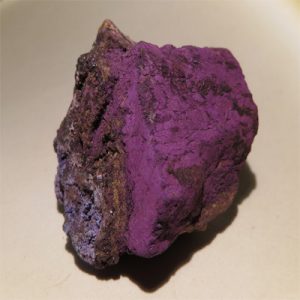Purpurite
Purpurite has a color almost unique in the gem world and even gets its name from the Latin word for purple. The chemical formula of Purpurite is Mn3+PO4 and its molecular weight is 149.91 gm. It is only found as opaque, massive forms so only available as cabochons. Cabochons are beautiful with the unique purple to purple-red color and satiny chatoyance. Purpurite is relatively rare since there is limited material available with consistent color in sizes large enough for cabochons. Purpurite has a specific gravity of 3.20 – 3.40 (g/cm3). and the refractive index of 1.85 – 1.92 Biaxial ( + ). There are several localities worldwide but the main source is the Karibib district, Namibia. There are some minor sources in the US including the Faires tin mine, Kings Mountain, Gaston County, North Carolina; at several mines in the Pala and Rincon districts, San Diego County, California; in the White Picacho district, Yavapai County, Arizona; large cleavages from the Crystal Mountain district, Larimer County, Colorado; at the Custer Mountain mine and other pegmatites in Custer County, South Dakota; from Branchville, Fairfield County, Connecticut; at Greenwood and Rumford, Oxford County, Maine.
| Category: | Phosphate minerals |
| Chemical Formula: | Mn3+PO4 |
| Molecular Weight: | 149.91 gm |
| Crystallography: | Orthorhombic – Dipyramidal |
| Crystal Habit: | Crystals are extremely rare; typically massive; cleavage fragments to 20 cm |
| Twinning: | None |
| Cleavage: | [100] Good, [010] Imperfect |
| Fracture: | Uneven |
| Tenacity: | Brittle |
| Moh’s Hardness: | 4.0 – 4.5 |
| Density: | 3.20 – 3.40 (g/cm3) |
| Luminescence: | None |
| Radioactivity: | Not Radioactive |
| Color: | Violet, Dark pink, Dark red, Reddish purple, (Brownish black from alteration) |
| Transparency: | Subtranslucent to Opaque; Transparent on thin edges |
| Luster: | Earthy (dull), Satiny |
| Refractive Index: | 1.85 – 1.92 Biaxial ( + ) |
| Birefringence: | 0.0700 |
| Dispersion: | Relatively strong |
| Pleochroism: | Strong; X = greenish gray, gray to rose-red; Y = Z = blood-red to purplish |


